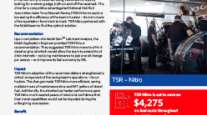Diesel Slips 0.7¢ to $2.939 a Gallon
By Rip Watson, Senior Reporter
This story appears in the April 5 print edition of Transport Topics.
The U.S. retail diesel average slipped 0.7 cent last week to $2.939, ending a string of five consecutive increases, the U.S. Department of Energy reported.
Though the price of commercial trucking’s main fuel dropped, it remains at the highest level since November 2008.
DOE also reported the retail gasoline average fell for the first time in six weeks, dropping 2.1 cents to $2.798 a gallon. However, crude oil hit a 17-month high.
Diesel now stands 32% above the price of $2.221 a year ago, while gasoline has climbed 37% from $2.046 during the past 12 months.
So far this year, diesel has gained 20.7 cents a gallon, and carriers should be preparing for modest increases of about 10 cents a gallon by summer, a DOE analyst said.
“For the next month or two, we expect crude oil prices to strengthen moderately, possibly a few dollars a barrel,” DOE analyst Tancred Lidderdale told Transport Topics.
Volatility lessened in oil markets during March, Lidderdale said, even though prices rose, staying in a range of about $5 a barrel on the New York Mercantile Exchange. It ended the month at $83.76.
In the prior two months, the range of oil prices was at least $8 a barrel.
Lidderdale said he expects a moderate increase to continue well into the summer driving season because demand for oil remains strong in overseas markets, including China and the Middle East, as well as a continued moderate pace in U.S. economic growth.
The increasing crude prices are putting renewed pressure on fleets, carrier executives said.
“We’ve seen about a 5% increase since mid-March,” said Robert McDowell, president of W.M. Dewey & Son Inc., Houston. “Diesel hit a low in mid-March, but it has been rising ever since.”
“Fuel prices have been steadily creeping up all year,” Greg Brown, chief executive officer of B.R. Williams Trucking, Oxford, Ala., told TT. “That forces us to continue to watch our margins very closely and try to do as much fuel conservation as possible.”
One money-saving strategy that Dewey has adopted is to obtain six competitive fuel prices each day. At the same time, Dewey coordinates its fuel purchases with its program for buying fuel at terminals in bulk two or more times a week.
Dewey, which primarily hauls oil-field equipment, has been hurt because some customers insist on using their monthly fuel surcharge instead of the weekly adjustments made by the fleet.
McDowell added that Dewey is fortunate in one respect.
“We may be a little better off than other fleets in the fact that many of our customers are oil-field companies, and they know about the cost of fuel. They understand when fuel surcharges go up because the product that they are selling is going up.”
Brown said B.R. Williams has cut costs by reducing speeds for road trucks and day cabs by 2 mph.
It also uses bulk fuel purchases for 82% of its needs, taking advantage of prices in its home state that are below the average retail price, Brown said.
Diesel prices in Alabama and surrounding states have averaged about 4 cents a gallon less than the national average this year, according to DOE.
Still another initiative, Brown said, is publishing the fuel economy results for drivers with similar equipment in the company’s 165-truck fleet so that they can see how they stack up against their peers.
The company hopes to restore bonuses based in part on fuel conservation as a further incentive to cut back on diesel expense, Brown added.
Those bonuses were discontinued in the past year, but Brown said it is a top priority to restore them if the economy continues to improve.
“We’ve seen a slight upward trend in diesel prices over the last couple of months,” said John Summers, vice president of customer solutions for Lester R. Summers Inc., Ephrata, Pa., which relies on fuel surcharges and in-cab technology to control fuel expenses.
“We have a weekly fuel surcharge that we adjust, and most of our regular customers accept it,” he said.
However, he said the overdimensional and flatbed hauler doesn’t have as much success collecting surcharges on backhauls because of excess capacity.
“We also monitor idling time,” Summers said, because of emissions laws, growing environmental consciousness and cost savings.
The company also is looking at in-cab heating and air conditioning to reduce expenses but hasn’t installed that equipment yet in its 80-truck fleet.




